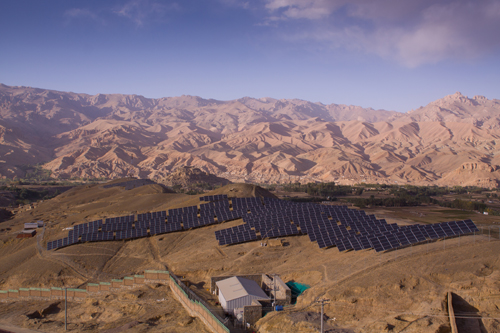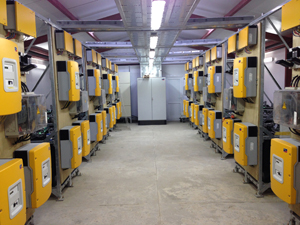Central Asia's Largest Off-grid Solar Power System: Bringing electricity & hope to Afghanistan
 Central Afghanistan’s Bamyan province is famous for the massive Buddha statues that were destroyed by the Taliban in 2001. But here, statues aren’t the only things left broken by the war. It also ravaged Bamyan’s schools and infrastructure, leaving communities, families, and citizens in desperate need of new developments. In 2007, 90% of Afghans still didn’t have electricity—a key component to the region’s economic growth.
Central Afghanistan’s Bamyan province is famous for the massive Buddha statues that were destroyed by the Taliban in 2001. But here, statues aren’t the only things left broken by the war. It also ravaged Bamyan’s schools and infrastructure, leaving communities, families, and citizens in desperate need of new developments. In 2007, 90% of Afghans still didn’t have electricity—a key component to the region’s economic growth.
Fortunately, now there’s a symbol of hope, thanks to the Bamyan Renewable Energy Project (BREP). One of the world’s largest off-grid power systems, BREP is a one-megawatt (MW) solar installation funded by the New Zealand Ministry of Foreign Affairs and Trade.
The project, which began in July 2012, has been creating jobs, improving lives, and bringing sustainable electricity to 2,500 buildings in Bamyan, including homes, business, schools, and more.
The power to change
“Reliable electricity transforms lives,” says Tony Woods, a New Zealand entrepreneur whose company Sustainable Energy Services International (SESI) led the project. “This project will bring medical care, economic development, and education that would’ve been impossible without electricity.”
Along with the essentials, the solar installation will also provide many basics that many of us take for granted. “It will light homes where children study at night, power computers and refrigerators, and create opportunities people only dreamed of just a few years ago,” adds Woods.
SESI has worked in Afghanistan since 1999, and over the years has built a team to design, construct, and maintain renewable energy installations. Woods says, “We recognized early on that it was more sustainable, cost-effective, and safer to train Afghan staff to an international standard than to use international staff.”
The company is currently still in Afghanistan, creating long-term jobs by training locals on installation, managerial, and financial procedures, along with maintenance.
Growing with demand
 Because power demand will continue to grow, the 1 MW solar system has been designed to generate power 24/7 and scale-up. Transformers and conductors are standardized to allow future integration into larger networks, and pre-pay power meters ensure financial sustainability. The installation includes batteries that store energy for nighttime use and for poor weather. In addition, three 275-kVA FG diesel generators have been added when required for backup and peak demand.
Because power demand will continue to grow, the 1 MW solar system has been designed to generate power 24/7 and scale-up. Transformers and conductors are standardized to allow future integration into larger networks, and pre-pay power meters ensure financial sustainability. The installation includes batteries that store energy for nighttime use and for poor weather. In addition, three 275-kVA FG diesel generators have been added when required for backup and peak demand.
For solar power to work, it was clear that the energy needs of the community needed to be met, but also in a cost-effective and reliable manner. This solar/diesel hybrid allows for the bulk of energy demands to be achieved with the low-operating costs of solar power, along with the security of a diesel backup system.
“And, as loads grow, a decision can be made about adding additional solar resources, or merging into a larger network,” says Woods.
A total of 4,250 x 250-watt solar PV panels were installed on steel racks on land donated by the local government. Multi-cluster technology was used, allowing smaller blocks of inverters to be grouped together. This way, they connect PV panels, battery systems, and diesel generators to provide hundreds of kilowatts of capacity. Newly built power lines were also added for approximately 100 kilometers of 20-kilovolt (kV), medium-voltage transmission and for 0.4 kV of distribution.
Flooded, lead-acid batteries were selected and added to the mix because of their cycle life, durability, and ability to handle temperature variations in Afghanistan. These 38-battery strings are equipped with single-point watering and low-water visual indicators for simple and effective maintenance. The 4,500 AH 48 VDC batteries are estimated to deliver non-stop power for a minimum of 12 years.
Built to survive
Bamyan is surrounded by mountains and war. There was no power infrastructure when the project began. As a result, every panel, wire, frame, battery, and every other component had to be imported. Woods’ team had to work with customs’ officials, or simply pause and begin again when a supply road fell into insurgents’ hands—or, when the Pakistani border closed for eight months. And then there’s the weather in Bamyan.
Temperatures can reach -25° C (-13° F) in the winter, with large snowfalls, and then spike during the summer. Such weather can cut the life of batteries and other equipment, which form the backbone of this project. The system had to be specifically built to survive the harsh conditions.
Despite rough weather and a poor infrastructure, SESI and a team of 15 Afghan engineers and almost 40 tradespeople had the power flowing in just 14 months.
The Bamyan Renewable Energy Project will continue to create jobs, while improving the standard of living and the local economy. It will also serve as a prototype for off-grid power that can be duplicated in other parts of Afghanistan, and around the world.
“I’ve been fortunate enough to get to know the people in Bamyan over the past few years, long before we even installed the first solar panel,” shares Wood. “I’ve seen firsthand how electricity changes lives.”
John Connell is the VP of SLI products at Crown Battery Manufacturing Company.
Funding for the Bamyan Renewable Energy Project comes from the Government of New Zealand. To learn more, visit www.sesinter.com.
Crown Battery
www.crownbattery.com
Author: John Connell
Volume: November/December 2014









.png?r=9037)

